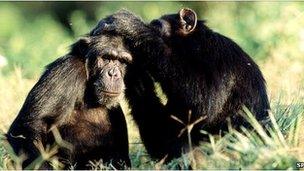Study says chimpanzees use 'human-like gestures'
- Published

Around a third of the manual gestures made by chimpanzees are similar to human ones
Wild chimpanzees communicate using similar gestures to humans, according to a Stirling researcher.
Dr Anna Roberts said she had identified about 20 to 30 manual gestures used by chimps, up to a third of which were similar to those used by humans.
The chimps' gestures included beckoning to make someone approach or flailing their arms to make someone leave.
It is hoped the finding may help researchers understand how humans evolved language.
Dr Roberts studied chimpanzees in the wild in Uganda over an eight-month period.
She believes the gestures suggest that a common ancestor of humans and chimpanzees must have used similar manual gestures.
'Mind-reading'
The Stirling University scientist said: "Chimpanzees use these gestures intentionally to elicit a desired response from other chimpanzees and they may be the missing link between ape and human communication.
"We now know that these gestures must have been in the repertoire of our common ancestor and might have been the starting point for language evolution."
The study found the animals used gestures to communicate a range of activities including nursing, feeding, sex, aggression and defence.
Dr Roberts also discovered that chimpanzees not only communicate using manual gestures, but are able to work out what the signaller means from both gesture and accompanying context.
She said: "The defining way that people understand communication with others is by figuring out what someone really means by 'mind-reading' their intentions and we have discovered that chimpanzees may have a similar ability."
Dr Roberts said the research showed that the basic elements for the evolution of language appeared to be present in our closest living relatives.
- Published29 March 2012